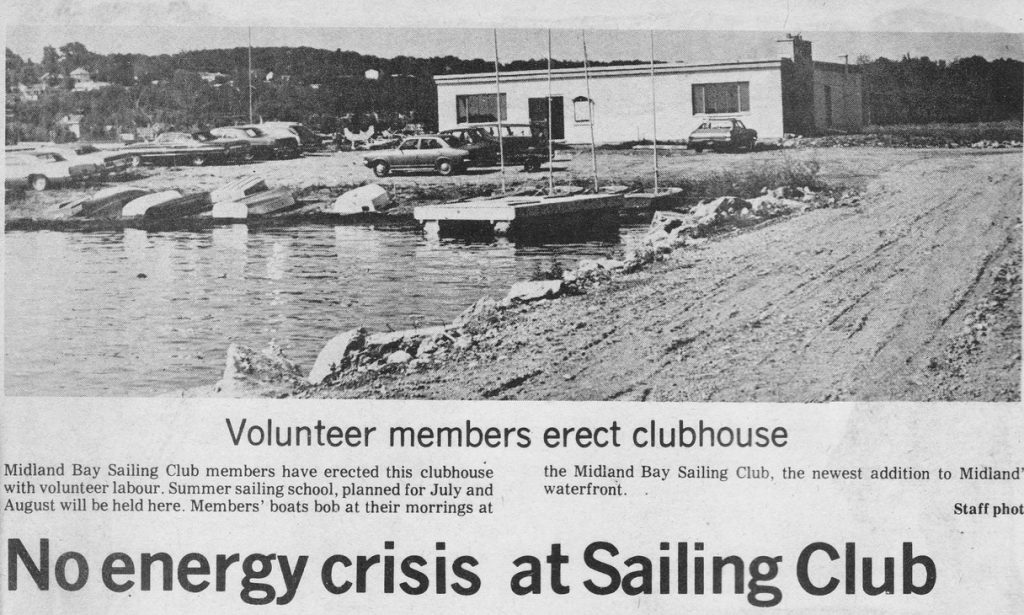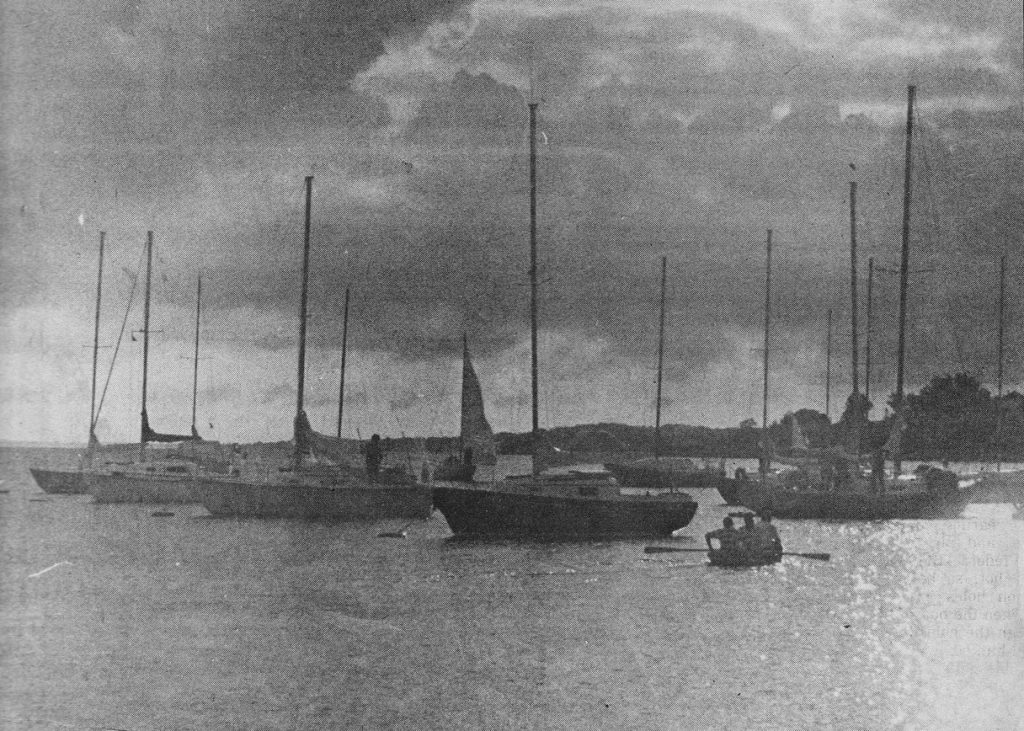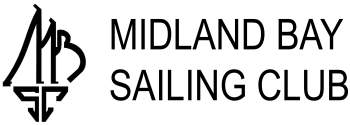The 1970s: A New Beginning
In the mid-1960s, sailing was moving away from a domain for the well-to-do and the die-hard enthusiasts and toward a sport that would be more widely enjoyed. The early Midland sailors that came together with a view to forming a sailing club to support their interest were part of the new wave. The focus was on sailboat racing and all of the friendships and social activities that went along with it. So it was from the time of the initial meeting hosted by John Daniells on November 23, 1967 that would lead to the formation of the Midland Bay Sailing Club, on into the early 1970s. It is no surprise that the original objects of the Articles of Incorporation that gave life to the Club spoke strictly to sailboat racing on Georgian Bay, but interest in cruising would soon become part of the mix. Changes in the focus of the Club were inevitable.
The first capital cost incurred by the Club was in 1969 when a committee boat was purchased and refurbished to go into service in the spring of 1970. That year the total revenue from members (19 full members and 35 associates) was $1,170.00 and the total expenditures were $1,155.00. It was a modest beginning but it suited the interests of the members at the time.
It was a time of fun and relative ease amongst the members. Sunday races and special events were well attended. The fleet was mixed but the Albacore group was well established and the Shark was considered to be the keelboat to be fostered for fleet development, although a strong Shark fleet would not be seen for many years to come. For mixed fleet racing, handicaps were the major concern and the critical meeting each year, held in the spring, was the Skippers Meeting when all manner of issues related to the race program and handicaps were discussed. The premier social event annually was the well-attended Bottoms Up Party, usually held in early November, where the presentation of sailing awards for the previous season was centre stage. By the time the Annual General Meeting came along in December, the boats were put away and there was little left to talk about. Typically, few attended the AGM in those days apart from those involved in the administration. The fun had all been had for the year and there was nothing left but to deal with the winter and wait for launch day in the spring.
By 1972, there was talk of trying to find a home for the Club and members were thinking in terms of doing some planning. A questionnaire was sent out to the membership but no record was kept of the results. This was the year the junior sailing program got underway with the help of Ed McGrath. Ed was one of the Club’s leading Albacore sailors at the time and he volunteered to devote one afternoon per week to the project. It would be the following year that the Club decided to formalize the sailing school program under the direction of a certified instructor. Talk continued about finding a home for the Club but consensus was not found and little progress was made.
In 1972 the membership structure of the Club was changed to provide for family memberships and the door was opened to women members. Until then, full voting membership was limited to men only. Ladies who were inclined to join could do so as social members and, as such, did not have a vote at Club meetings. The suffragettes were well ahead of the male dominated MBSC but, following a special meeting held that year when the room was packed and the discussion lengthy and sometimes heated, the male members present finally saw the light. In that respect, the Club moved into the modern era. On a lighter note, this was the year that Post Office Box 63 was first rented at the Midland Post Office and the first Albacore invitational regatta was held.

The following year (1973) saw a move toward securing a home for the Club. The Town of Midland commissioned a planning study respecting parks and recreation and the recommendations of the planners included the establishment of a sailing club for public participation. Independently, the membership as it evolved included many who were more interested in just going sailing and exploring Georgian Bay than limiting their on-water activities to racing. A cruising committee was set up and before the year was out, the objects of the Club were amended to include the cruising component. By the end of that season, land had not yet been offered to the Club by the Town but there was some optimism that a home was in the offing.
1973 also saw the introduction of the Georgian Bay Racing Conference, which was a forerunner of the Georgian Bay Regatta, largely the brain child of Al Woolnough and others of the Collingwood Yacht Club. Members of the MBSC participated in the founding of that organization. Back home, the members approved the first purchase of boats for the sailing school which went into service in 1974 off the beach at the home of Harvey and Marg Payne. Membership consisted of 43 Full and Family Members, 23 Associates and nine Junior Members. Club assets at the end of the year totaled $4,014.21, consisting of $2,858.20 cash and the committee boat, and the operating expenses were $1,282.32. Not a lot to go on with the possibility of a property acquisition looming.
Overall, 1974 was a critical year for the MBSC. The Town offered our present location to the Club, which resulted in a sharp redirection in focus. The race program and related social events had sustained the Club to this point but, with the inception of the sailing school and the growing interest in cruising, finding a location to continue the development was becoming more popular. However, the notion of a club facility of this nature was not embraced by all. There was a clear division between those members who were anxious to move in this direction and those who simply were not interested. It was a struggle but the visionaries won out and there was to be a new beginning for the MBSC.
Leasing and Developing the Property
With so little money in the bank, finding a development proposal acceptable to the members was challenging. The offered property is actually filled land and it was wet with a stream flowing through it. The budget to dredge the inland area to create the lagoon and provide docks was thought to be in the order of $100,000.00 and that proposal was rejected before it could be fully explained. An alternative was to simply level the land, do some drainage, build a clubhouse and sink moorings out front for use by the members. The budget for that much was estimated to be $25,000.00 and even that was not an easy sell.
The options were discussed at a special general meeting held on July 6, 1974. There was a reluctance on the part of those present to contribute as much as $500.00 each, particularly where there was no prospect of being repaid in the foreseeable future. The most the Club could offer was an entitlement to a mooring and/or a dock as they came available and the opportunity to participate in creating the new facility. The proposal for a more ambitious beginning was flatly rejected. No decisions were made at that meeting but at least it was agreed that there would be further discussions.
The executive went back to the drawing board and a second special general meeting was scheduled for October 15 that year. The proposal that went to the meeting included:
- Full members would contribute $300.00 each as a loan to the Club, non-interest bearing and with no schedule for repayment.
- It was forecast that the Club would grow and that new members would make the same contribution.
- A seniority system for moorings initially and hopefully docks eventually would be established based on the time of payment of the assessment as the only tangible benefit members would derive in the short run.
- The deadline for payment would be March 1, 1975.
- Social memberships would be eliminated for the foreseeable future.
The October meeting was not well attended, which spoke to the reality that not many shared the vision or were willing to make the commitment. However, the proposal was accepted by those in attendance with some minor changes and the development could begin.

Even then, growth in the membership was critical to long term success and those who came to the Club later were a critical part of the success that has been enjoyed since. As it happened, the membership began to rebuild, there was great participation in work parties and 12 to 25 moorings were projected for the 1975 season. By the time of the AGM in 1974, the lease with the Midland Board of Parks Management had been signed, footings for the building were poured, frost walls were erected and the backfilling was underway with the anticipation that the building would be erected in 1975. The executive reports for the 1974 AGM included the following which may have summed up the enthusiasm for the new facility:
“The story of the year is, of course, the property. We have gone from a hopeful position with respect to a home for the Club to a position of reality. Although we have discussed the acquisition of land and buildings for years, many of us were shallow on faith.”
That was the new beginning for the MBSC and it is through the dedication and commitment of those who followed that the Midland Bay Sailing Club has enjoyed such great success from that time forward.
One of the stipulations in our lease with the Town is that the Club is required to accommodate access to Georgian Bay from the boat launching ramp built by the Town at Pete Petersen Park. It would not be until 1980 that sufficient dredging would be done to create the channel along C dock and the inner lagoon to allow for public access from the park ramp to the Bay. Given the modest beginnings of the Club, it would take a lot of money we did not have to fulfil the obligation any sooner. But, it got done. Fortunately the Club received a grant from Wintario and there was a time when several of the directors of the Club agreed to sign personal guarantees at the bank to allow the Club to borrow the money it needed to fund various projects along the way. By 1981 the lagoon was completed, the inner docks were built, pumpout facilities were finished, the crane that was replaced in 2015 was installed, and a dinghy shed was built. Most of the mess was over by the end of that year but the capital improvements have continued ever since.
This was a significant period in the history of the Midland Bay Sailing Club that saw the Club expand its focus and begin the development of the facilities that we have today. Since then the membership has grown and the enthusiasm for a great sailing community has not wavered. It has not always been easy but it surely has been worth the trouble. Hopefully there will be others who have tales to tell about the challenges that have been faced along the way and who will contribute to the telling of the story of the Midland Bay Sailing Club.
—Ted Symons
A few highlights from 1975:
- Half the membership was lost when the contribution to the building fund was required.
- Two additional Flipper scows were purchased for the sailing school at a cost of $3,650.00.
- The breakwall and mooring plan were approved by the then federal Department of Transport. The breakwall was started and by June 1975 it extended out 143 feet from shore.
- By the time of the publication of the March 1975 Snake Island Buoy, 29 people had paid the building assessment and that was the extent of the membership. By April 7, the numbers had increased to 40 and it was enough to keep going.
- Fred Hehl, a local contractor, was hired to do the footings and slab for the building. The active members contributed a great deal of time to the property development.
A story of its own is the size of the building. The Midland Board of Park Management had maintained a two-story, frame boathouse in Little Lake Park for many years and had decided to replace it. They offered the building to the Club and, with funds so short, it was gratefully accepted. The size of the boathouse was 30 feet by 60 feet and it was to be taken down and re-erected on a slab of the same size that had been prepared by Fred Hehl. A local man by the name of Julien Ladouceur was hired to take the boathouse down but something was lacking in the communication. Julien took it down alright but with a chain saw. When the remnants were delivered to the Club property, it looked like a pile of junk. So, a decision was made to have Fred erect a building of the same size with concrete block walls and a flat roof. The posts and beams that can be seen in the building today are part of what was salvaged from the boathouse takedown. Some of the lumber was used for other small buildings on the property which have all since disappeared and lots was used for fire wood.
About the Author
Ted Symons has been a member of MBSC from 1970 and was Commodore in the years 1972-74 and 1979-80. He was made a Life Member in 2003. Sailing for Ted has been primarily on the race course, first competing in a Snipe, then moving to an Albacore and from there to a Soling in the middle 70s. His most recent participation has been with the Shark fleet. Now retired, he practiced law in Midland, having settled in Midland following graduation from law school in 1969. Ted served as Mayor of the Town of Midland from 1988 to 1994 and has been the MBSC go-to person for legal matters and dealings with the Town for many years.
